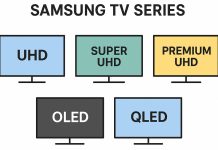LED TVs have one distinctive feature: when the pixels are off, they still allow light from the backlight to pass through—this is a characteristic of LED display structure. As a result, they can never show true black; instead, black appears as dark gray. TV manufacturers decided to turn this drawback into an advantage and developed algorithms that turn off the backlight when displaying black. Each brand came up with its own name for local dimming technology, leading to about 50 different terms for screen dimming. Some companies even have around ten of them, even though these algorithms are now standard subroutines built into the processor, and TV manufacturers no longer develop or maintain their own local dimming systems.
Types of Local Dimming
As mentioned earlier, despite the overwhelming number of branded names, there are really only three main types of local dimming. Technically, each can be further divided depending on the specific type of LED panel used, but those distinctions aren’t particularly meaningful for most consumers. Instead, let’s focus on the three core types of local dimming you’ll actually encounter in modern TVs.
Edge-Lit Local Dimming
In edge-lit LED TVs, local dimming is often more of a marketing term than a functional feature. These TVs use LED strips located along the edges of the screen—most commonly at the bottom—that project light across the entire panel. Because this type of backlighting illuminates large sections of the screen at once, precise dimming is extremely limited. In theory, the TV might dim just the left or right half of the screen, but that’s rarely useful in real content. The algorithm behind this dimming method is usually very basic, and it typically only shuts off the backlight when half of the screen is entirely black—which is a rare scenario. In practice, edge-lit TVs—especially budget models—don’t offer meaningful local dimming at all.
Full-Array Local Dimming (FALD)
Full-array local dimming became possible with the introduction of LED panels that have backlighting spread across the entire surface behind the screen. In these TVs, the LEDs are divided into zones that can be controlled independently. In entry-level models, there may be only a handful of zones and fairly simple dimming logic. Higher-end models may feature dozens of zones with more refined control, allowing for more accurate dimming based on what’s happening on-screen. While this approach does offer visible improvements in contrast, it still has limitations: each LED zone typically covers a large portion of the screen, so precision is limited, and you may notice issues like blooming or halo effects in dark scenes with bright highlights.
Mini LED
Mini LED technology is a major leap forward in backlighting. These TVs use hundreds to thousands of extremely small LEDs across the entire back panel, enabling a dramatically higher number of dimming zones. This allows for far more precise control of brightness and darkness across the screen. As a result, mini LED TVs can deliver much better contrast, deeper blacks, and improved performance in dark scenes compared to traditional LED models. The local dimming in these displays actually works well and delivers results that rival OLED in some scenarios—particularly in brightness. However, this level of performance comes at a cost: mini LED panels are still expensive and typically reserved for high-end or flagship TV models.
Local dimming and marketing
Marketing actively uses the term local dimming, sometimes even when the technology is poorly implemented or completely absent. Manufacturers come up with their own names — such as “Micro Dimming,” “UHD Dimming,” and “Supreme Contrast” — which sound impressive but technically may mean simple software image processing without real backlight zones. Moreover, buyers are rarely informed of key characteristics: how many dimming zones are used, what type of backlighting is used, and whether there is a halo effect around bright objects on a dark background. All this creates the illusion of premium quality, while the real picture may be far from ideal.
As a result, local dimming has become less of a technical feature and more of a marketing tool. It is especially common in mid-range and budget TVs to add weight to the specifications. The real advantages are only visible in expensive models with full-array local dimming (Full Array Local Dimming or Mini-LED) and a powerful image processing processor. The rest is largely an illusion supported by advertising slogans.








